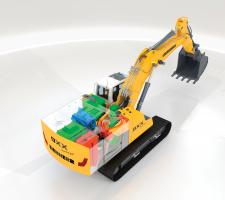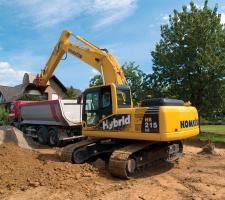
While engine technology continues to develop apace, equipment manufacturers are looking at every aspect of the machine, to increase efficiency and boost productivity, writes Dan Gilkes.
Often that will involve fine tuning transmissions, hydraulic pumps and motors to work at their most efficient in combination with the engine, but it is also leading to innovative driveline solutions.
In the wheeled loader market, the latest transmission to catch the imagination of engineers and designers is the combined hydrostatic/mechanical unit, sometimes known as a continuously variable transmission (CVT) or a hydro-mechanical variable transmission (HVT).
Traditionally, manufacturers have gone down one of two routes with wheeled loader drivelines, opting for either a full hydrostatic transmission with a hydraulic pump and motors, or a powershift mechanical automatic transmission. The split has often been based on size and weight of the machine, with hydrostatics being favoured for smaller equipment and mechanical powershift transmissions more common in higher powered production machinery. The exception to this rule has been
Both systems have their benefits and their downsides. A hydrostatic transmission provides maximum controllability and can be operated independently of engine rpm, to allow the operator full throttle for the loader arm lift while creeping forwards with the transmission for instance. However hydrostatics traditionally becomes less effective as the machine’s weight rises and as speeds increase, with fluid losses making them less efficient than a direct drive mechanical box.
Conversely, powershift mechanical transmissions, particularly those with lock-up torque converters, offer a high degree of efficiency at higher speeds and increased rimpull and digging traction at lower speeds, but can be less efficient at lower operating speeds and in smaller equipment.
With the CVT/HVT option, manufacturers are attempting to combine the best of both systems, utilising a hydrostatic drive for lower speeds and a mechanical gearbox as those travel speeds rise.
Liebherr is one of a growing number of manufacturers investigating the benefits of a wheeled loader with a power-split hydrostatic-mechanical transmission. The driveline concept has been applied to the firm’s largest wheeled loader, the L586, which has a tipping load limit of approximately 20tonnes.
The continuously variable power-split transmission combines mechanical and hydrostatic drivelines. The diesel engine’s power output is divided between the two sections of the driveline and recombined where they come together. This principle reduces energy transmission losses and increases efficiency.
An electronic transmission control system ensures that the highest possible ratio is selected and allows the diesel engine to run at a lower speed, which in turn reduces fuel consumption.
The combined effect of the two halves of the transmission is increased performance at all stages of the work process. When driven slowly, or when picking up material, the wheel loader is largely driven through the hydrostatic transmission. As speed increases or during lengthy work cycles, the proportion of power transmitted mechanically increases. Low internal losses in the mechanical driveline are the key to its high efficiency.
The continuously variable transmission has the same functional principle in forward and reverse gears, so top speed and efficiency levels are identical in either direction. Liebherr plans to adopt this driveline across its complete range of large wheeled loaders in time.
Power is transmitted through the variator unit as well as through a parallel mechanical gear path, the two being combined through a series of planetary gears to maximise efficiency over a wide range of operating conditions.
The good news for operators is that they don’t have to do anything in particular to get the best from the system. The 966K XE has two pedals and the transmission automatically reduces speed when engaging the stockpile or quarry face, leaving full power for the lift arm circuit.
Caterpillar claims that the transmission system offers up to a 25% fuel efficiency gain for the 966K XE. Initially available throughout western Europe, we can expect the transmission to find its way onto other Cat loader models and into a wider spread of countries going forwards.
It isn’t just the machine manufacturers that are looking at CVT transmissions however. Earlier this year both Dana Rexroth Transmission Systems and
For ease of maintenance Dana has opted to mount the hydrostatic drive outside the mechanical gearbox and the combined transmission can cope with up to three power take-offs to run auxiliary systems, including hydraulic drive for cooling fans.
ZF’s cPower CVT takes the system one stage further, by also incorporating a start/stop function. In addition ZF says that the transmission can be used to recover energy from regenerative braking in a hybrid application.
While there have been moves towards hybrid powertrains in wheeled loaders, the crawler excavator market seems to be leading the way in hybrid technology. This is thanks in part to the repetitive nature of excavator operation, with the slew motor in particular providing an easy source of regenerative braking force and a way in which that electrical energy can be reused.
Equipped with an electric swing generator/motor and ultra-capacitors to store the electrical energy, the HB215 uses kinetic energy generated during the slew braking phase converted to electricity. This is then sent through an inverter and captured in the ultra-capacitor. The energy is discharged to assist the engine and for upper structure rotation, allowing the same power with a smaller diesel engine.
Komatsu says that in the right operation, one where the machine is regularly slewing, the hybrid system can save as much as 25% in terms of fuel, with an equivalent reduction in CO2 emissions.
This means that the kinetic energy from the slew braking is stored in a hydraulic accumulator, rather than as electrical energy in a super capacitor. When the machine requires power the accumulator releases the energy to boost the engine’s output. Hyundai claims that the concept can save as much as 20% in fuel efficiency terms.
Liebherr is also looking at hybrid technology, though he firm has based its research on a much larger 40tonne excavator in the R9XX concept. Using a 160kW engine, which is much smaller than would be expected in a machine of this size, the concept combines both electrical hybrid and hydraulic hybrid technologies.
Controlled by the Liebherr Power Trin Competence Centre, the machine takes electrical energy from the slew brake and stores it in super capacitors. However it also has a pressure reservoir and a generator to store hydraulic energy delivered by the lowering of the main lift cylinders.
Energy is returned to the driveline either through the electric slewing motor or to the hydraulic pumps, reducing the power required from the diesel engine.
UK engineering firm Ricardo is also developing an energy recovery system that can be integrated into an excavator’s hydraulic system. Known as the High Efficiency Excavator (HFX) project, the system uses a 5kg carbon fibre flywheel that is encased in a vacuum-sealed cartridge, which contributes to minimising friction. The flywheel is spun at speeds of up to 30,000rpm using a magnetic coupling, which is driven from a hydraulic motor.
Power for the hydraulic motor comes from oil returning from the hydraulic system, so energy can be recovered from boom lowering, dipper extension and slewing. The faster the flow of oil through the motor, the greater rotational speed achieved by the flywheel.
Energy is returned to the hydraulic system by simply using the flywheel and its magnetic coupling to then drive the hydraulic motor and assist the engine in powering the hydraulic system. Peak power from the flywheel system can be as high as 100kW, but the progressive release of flywheel energy allows a controlled amount of power to be put back into the system for short bursts.
Ricardo says the system is a low cost option compared to super-capacitors and battery packs, and that it suffers no performance degradation over its lifetime. Importantly it can also be retro-fitted to almost any excavator, promising a much faster integration if there is a take-up. Ricardo claims that the potential fuel savings when used on a 24tonne excavator would cancel out the cost of the flywheel energy recovery system within a year.
While some of these futuristic-sounding systems may be a few years from series production, both the Komatsu hybrid excavator and Cat’s 966K XE wheeled loader are available right now. The future it seems is a lot closer than you might think.
















